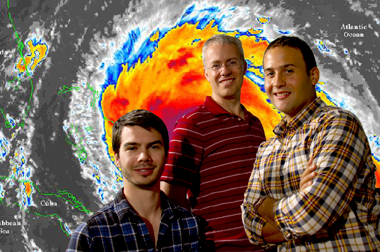UAlbany Students Join NASA Mission to Discover Why Some Storms Pack a Wallop
ALBANY, N.Y. (September 7, 2012) -- Mike Ventrice and Alan Brammer are packing their bags for a “cool” mission at the NASA Wallops Flight Facility in Virginia. The UAlbany doctoral students will forecast when to deploy two unmanned Global Hawk aircraft into developing tropical storms in the Atlantic Ocean basin.
 |
|
From left, Alan Brammer, Professor Chris Thorncroft, and Mike Ventrice, are involved with the NASA mission. (Photo by Mark Schmidt) |
Along with fellow Department of Atmospheric and Environmental Sciences graduate student Jason Dunion, Professor Chris Thorncroft and his UAlbany colleagues John Molinari, Kristen Corbosiero, and Lance Bosart, Ventrice and Brammer will join the $30 million NASA mission, the Hurricane and Severe Storm Sentinel (HS3), specifically targeted to investigate the processes that underlie hurricane formation and intensity change in the Atlantic Ocean.
The mystery surrounding why some storms quickly intensify into dangerous hurricanes remains unsolved, and more advance warning of an approaching storm would help protect people’s lives and property.
“The cool factor comes from the fact that we will be flying two unmanned aircraft to measure hurricanes and their environment – to learn about the birth of hurricanes as well as factors that determine how intense these hurricanes can become and what determines whether a hurricane will intensify rapidly or not,” said Thorncroft, who added UAlbany will be involved in the project in 2013 and 2014 as well.
Of the $30 million obtained by NASA for the project, Thorncroft’s research is funded at $684,488. DAES colleagues Corbosiero and Molinari obtained an additional $300,000 grant to work on the same project. In addition, graduate student Jason Dunion successfully led a proposal with Lance Bosart (DAES) and Chris Velden of the Space Science and Engineering Center (SSEC) at the University of Wisconsin-Madison that obtained $325,000. In addition to doing his Ph.D. at UAlbany, Dunion also works for the NOAA Hurricane Research Division in Miami and was key to helping coordinate manned NOAA aircraft missions with NASA Global Hawk flights. Dunion is also leading the coordination of the Hurricane Research Division’s daily map discussions that are used for planning NOAA’s field activities during the season.
Lee Harrison of the Atmospheric Sciences Research Center (ASRC) is also participating in HS3 - he is carrying out collaborative research (funded by NASA and the Office of Naval Research) with Yankee Environmental systems to develop atmospheric observation instrumentation that will be deployed on the Global Hawks in 2013.
Ventrice, of Patchogue, N.Y., who plans to graduate in December, said, “This field campaign is unique and it is an honor to be part of such an event. UAlbany is one of a few select universities contributing to the field campaign. Albany is developing a number of products to use operationally for forecasting the formation of Atlantic tropical cyclones.”
As part of a small team of two or three forecasters, he and Brammer will be on the lookout for areas where a tropical cyclone may form or intensify.
Brammer, of Macclesfield, England, said, “Making a correct forecast and being able to position the Global Hawk over a developing system for such a long period of time and thus capture those early periods of development will be very useful for trying to understand the cyclogenesis process.”
One of the benefits of the upcoming forecasting mission for NASA is that the planes allow for extended flight times and observations further East than is typically attainable.
“Each Global Hawk can literally fly over the hurricane for 24 hours continuously,” said Molinari. “We have never had anything close to that capability with other aircraft.”
Brammer added that they will be studying the environment surrounding storms as well as the inner dynamics within a storm, to better understand the interaction between storm and environment.
The experience also gives UAlbany students a competitive edge.
“Being a member of a field campaign [like this one] is highly desirable because it shows future employers that you have true experience in the field. Further, it allows you to meet a broad range of professionals who will help you find your career path,” said Ventrice.
Learn more about a major in atmospheric science. For more UAlbany news, visit the News Center.
![]() For more news, subscribe to UAlbany's RSS headline feeds
For more news, subscribe to UAlbany's RSS headline feeds
A comprehensive public research university, the University at Albany-SUNY offers more than 120 undergraduate majors and minors and 125 master's, doctoral and graduate certificate programs. UAlbany is a leader among all New York State colleges and universities in such diverse fields as atmospheric and environmental sciences, business, education, public health,health sciences, criminal justice, emergency preparedness, engineering and applied sciences, informatics, public administration, social welfare and sociology, taught by an extensive roster of faculty experts. It also offers expanded academic and research opportunities for students through an affiliation with Albany Law School. With a curriculum enhanced by 600 study-abroad opportunities, UAlbany launches great careers.


